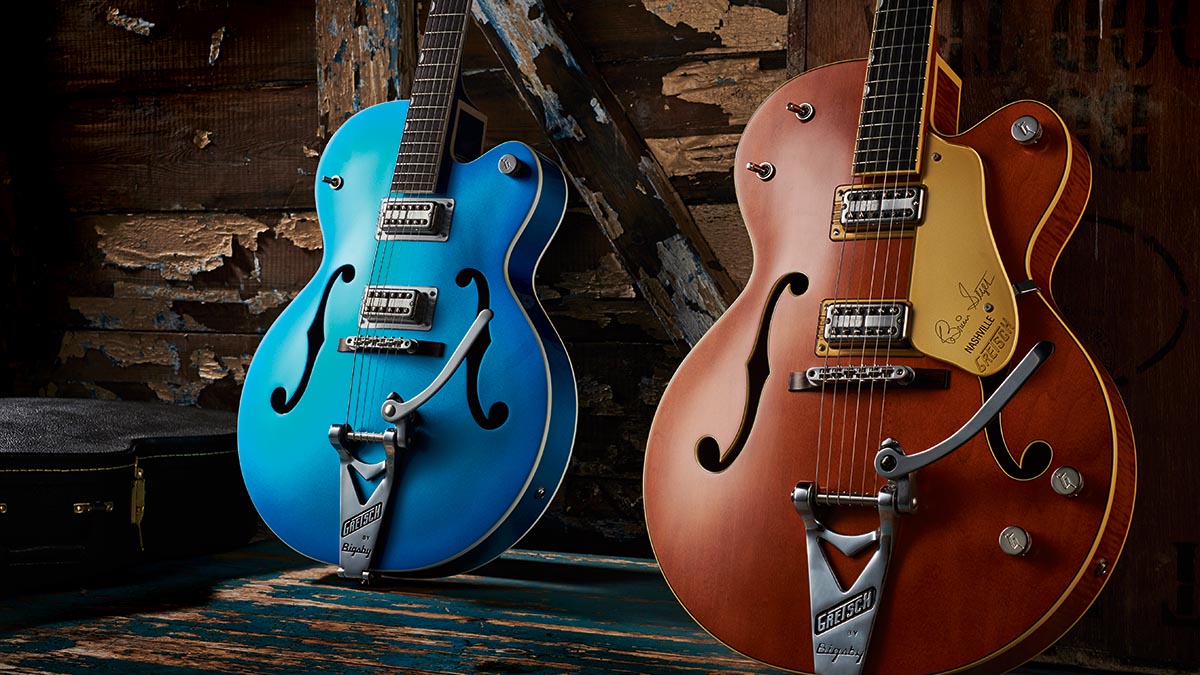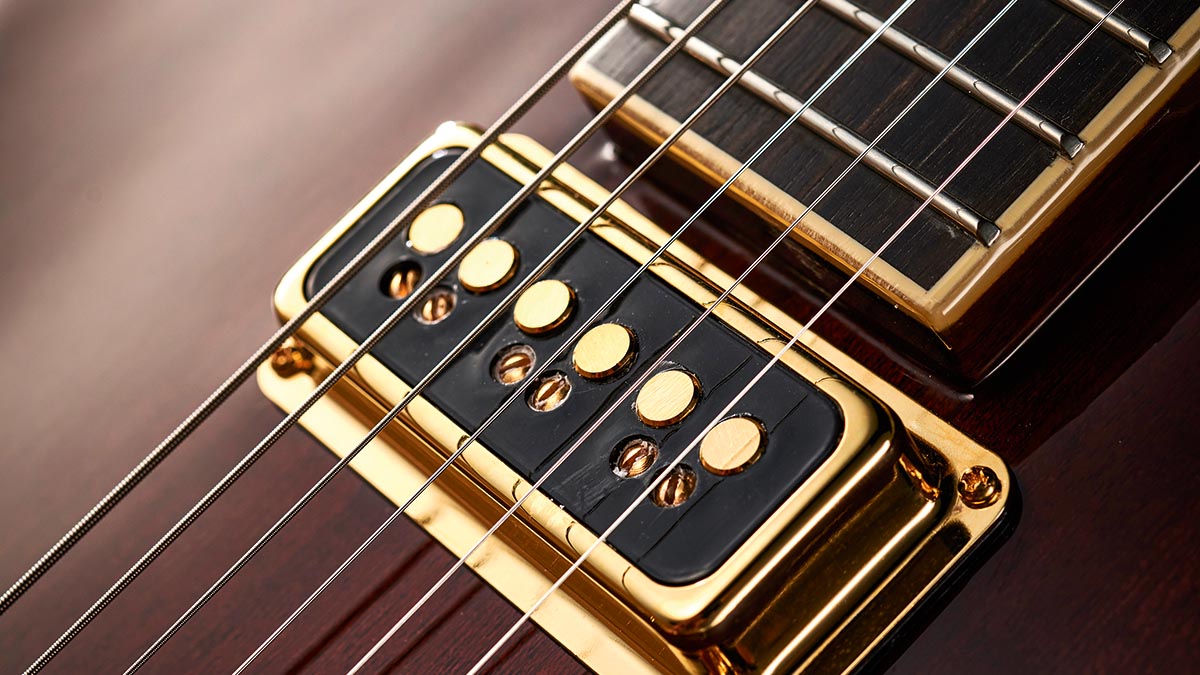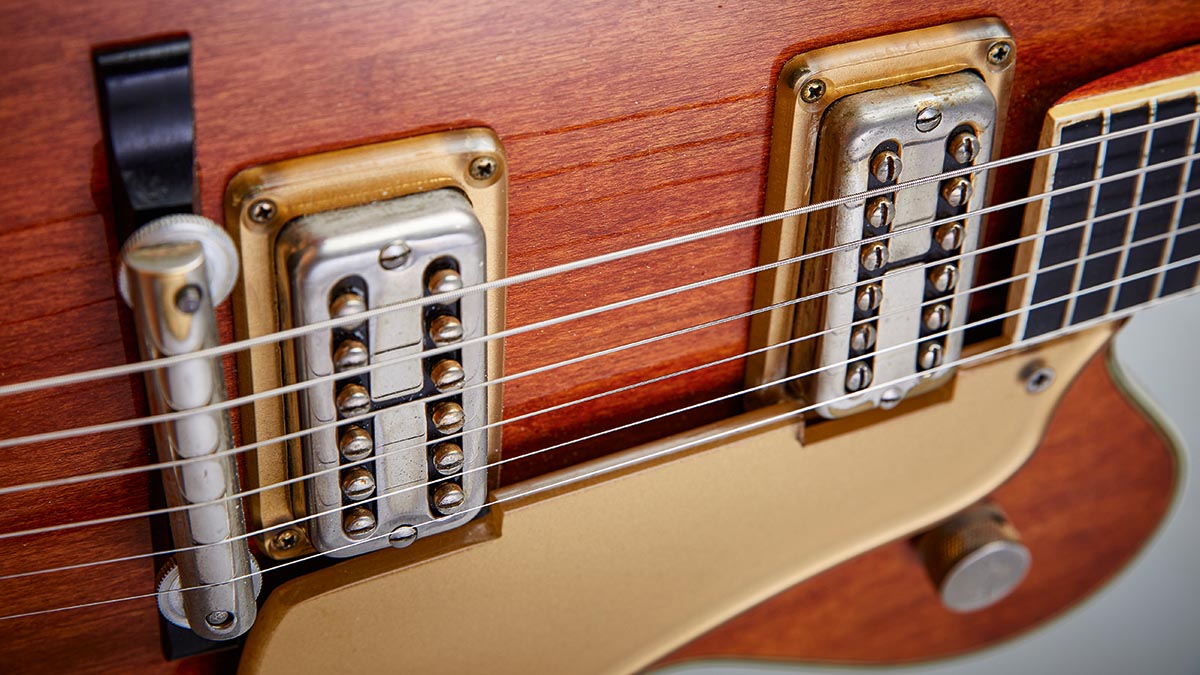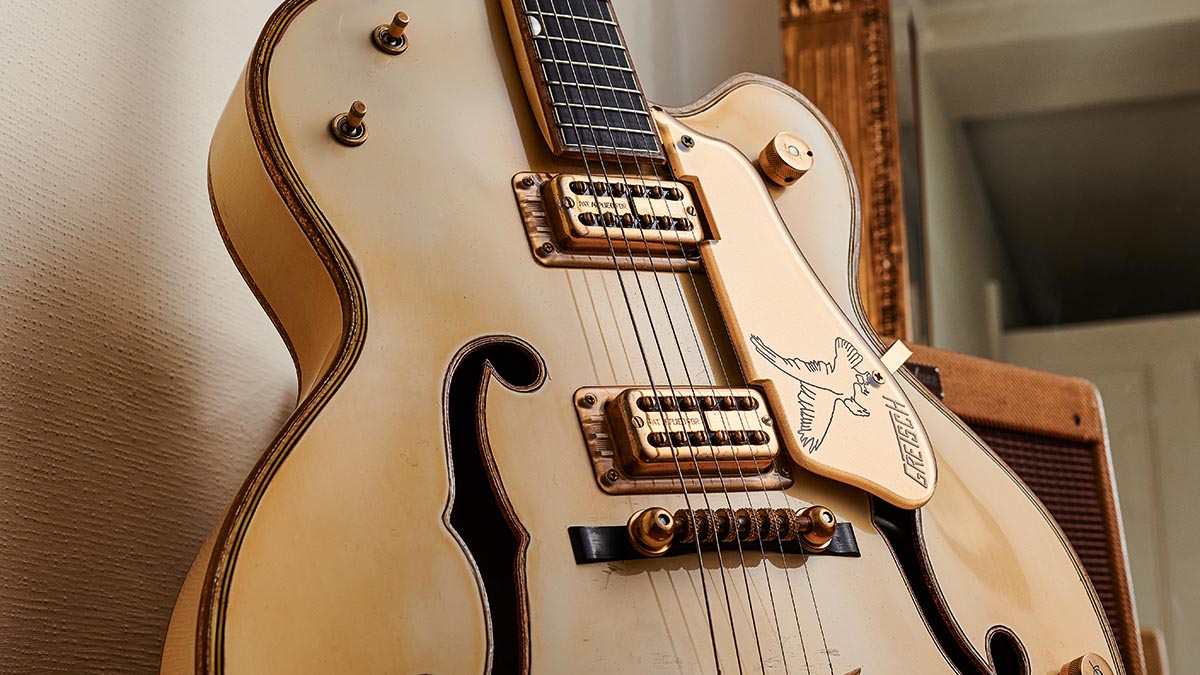
It’s astonishing that Chet Atkins, George Harrison, Neil Young, Steven Stills, Malcom Young, Pete Townshend and Brian Setzer all relied on the same electric guitar pickup to achieve some of their greatest tones.
Whether it’s country fingerstyle picking, ’60s rock, indie jangle, power pop or classic rock, the Filter’Tron can do it all. Even so, this particular pickup fell out of favour for over a decade after music became heavier and louder, and players became sustain-obsessed. The main issue was that they were exclusive to hollowbodied Gretsch electric guitars that were largely unsuited to the latest trends.
In the early 1980s, a Long Island greaser called Brian Setzer brought his virtuoso chops to the rockabilly revival and made Gretsch guitars cool again. Goths and indie players followed suit, with the likes of Billy Duffy, Kirk Brandon, Roddy Frame, Ian McNabb and Johnny Marr breaking new sonic ground.
When Fred Gretsch relaunched the family firm during the 1990s, pickup manufacturers gradually got in on the Filter’Tron act. And these days, it’s possible to retrofit Filter’Trons into a wide variety of guitars without making major modifications.
Getting ’Bucked
Was the first humbucker Seth Lover’s Gibson PAF or the Filter’Tron Ray Butts designed for Chet Atkins? The actual answer is neither. The ‘humbucking’ principle had its origin in transformer manufacturing and was employed by the tape machine company Ampex for hum-cancelling record heads, and microphone manufacturer Electro-Voice.
The first humbucking pickups actually appeared in the late 1930s and were used by Baldwin, Vega and others, while Les Paul reportedly employed hum-cancelling dummy coils and wound his own stacked humbuckers back in the 1940s.

Seth Lover had already used a humbucking circuit in the power supply choke of an amplifier he designed for Gibson and understood that the same technique could be applied to pickups. Meanwhile, over in Cairo, Illinois, Ray Butts was busy working on a humbucking pickup design of his own.
Get The Pick Newsletter
All the latest guitar news, interviews, lessons, reviews, deals and more, direct to your inbox!
Ray had established his reputation as a custom amp builder, and his Echosonic amplifiers featured an integrated tape machine to replicate the studio echo effects popularised by Les Paul and Sam Phillips.
They sounded excellent, and Ray’s tape echo design was so innovative that Mike Battle and Don Dixon basically copied it to develop the Maestro Echoplex. Clearly, Ray was well versed in tape technology and later confirmed that the Ampex hum-cancelling record head inspired his pickup design.
Ray’s tape echo design was so innovative that Mike Battle and Don Dixon basically copied it to develop the Maestro Echoplex
Prior to the official launch of the PAF and Filter’Tron, Ray and Gibson president Ted McCarty became aware of each other’s work. They exchanged some strongly worded correspondence, with McCarty flexing his corporate muscles and Ray standing his ground. Both pickup designs debuted at the 1957 Summer NAMM Show and there never was a legal showdown.
With several humbucking pickup patents having already been granted, Seth Lover and Ray Butts were eventually awarded theirs for the adjacent coil arrangement. Ray received his patent on 30 June 1959, a month before Seth.

Chet’s request
Les Paul and Chet Atkins were guitar-playing superstars in the 1950s. Both players had signature models, with Les endorsing Gibson and Chet Atkins playing Gretsches – in public, at least. Chet was an intelligent and sophisticated man, who was somewhat embarrassed by some of the more hokey ‘Western’ features on his 6120 signature model. But that was nothing compared with his dislike of Dynasonic pickups.
Unlike Gibson, Gretsch didn’t manufacture pickups in-house. Instead, Gretsch bought in DeArmond Dynasonics and Chet struggled to achieve a comfortable string-to-string balance for his thumb-and-fingerpicking playing style. He also felt that the strong Dynasonic magnets compromised sustain. But most of all, he objected to the single coil-hum.
Chet recalled: “I kept telling Ray how unhappy I was. I had to twist my body around to get the guitar in a certain position relative to the amp to get rid of the humming. One day, he came down to Nashville and had this rough-looking pickup on an old guitar. He said, ‘How would you like a pickup that doesn’t hum?’”
Ray’s extensive records and development notes demonstrate that he didn’t simply knock up some hum-cancelling pickups on a whim. He recalled showing Chet a humbucking pickup in 1954, and he worked long and hard on the design before Chet finally installed a prototype set with white bobbins in his black 6120 prototype.
Chet was first photographed playing the guitar with Ray’s pickups at a Grand Old Opry show in September 1956. Around that time, Chet approached Gretsch about using Ray’s pickups and Fred Gretsch wrote to Ray requesting samples. With DeArmond selling pickups to the company’s competitors, Gretsch’s management was already considering other options.
Perhaps wary of ending up in the same predicament, and knowing that Ray Butts was really an inventor and small-scale custom builder, it was agreed that Gretsch would manufacture Ray’s pickup design in-house and pay him a royalty. Ray and Jimmie Webster collaborated to develop a production version of the pickup, which was first marketed as the ‘Filter’Tron Electronic Guitar Head’.

Cover versions
With Ray’s patent pending, the earliest Filter’Trons had plain metal covers, but they soon began stamping ‘patent applied for’ across the centre bar in block capitals. After the patent was granted, Gretsch must have used up its backlog of covers because the cover stamp wasn’t changed to ‘U.S. Pat 2892371’ until 1960. Gretsch ran out of Filter’Tron covers in the mid-60s and for a short period Filter’Trons were assembled with open top HiLo covers instead.
Vintage ‘patent applied for’ Filter’Trons are not held in higher esteem than the patent numbered versions. Unlike Gibson humbuckers, there were no differences in the way Filter’Trons were manufactured. When players do express a preference, it’s more likely a 1950s versus 1960s thing because Gretsches are so popular with rockabilly players.
Magic ingredients
Gretsch used semi-transparent nylon bobbins that were significantly smaller than Gibson’s. This enables the pole screws of each bobbin to be placed much closer together, which narrows the pickup’s area of focus – much like Gibson’s later mini-humbuckers. Coils were machine-wound using 42 AWG plain enamel magnet wire and left unpotted.
Examples from the 1950s and 60s tend to read anywhere between 4kohms and 5k due to the limited amount of wire that can be wound onto the bobbins, but don’t fooled – Filter’Trons are not weak-sounding pickups.
The design has Alnico bar magnets that are double the thickness of the ¼-inch ones Gibson uses. The pole screws are also longer, so Filter’Trons have stronger magnets and higher inductance, which contributes to their sweet chime and growly twang.
The pole screws are also longer, so Filter’Trons have stronger magnets and higher inductance, which contributes to their sweet chime and growly twang
The type of Alnico may have varied depending on what Gretsch’s suppliers had in stock, but the consensus is that Alnico V is ideal. After Baldwin’s takeover, they started using cheaper ceramic magnets with fully open covers and pole screws concealed by a plastic cover. This type of Filter’Tron is called a ‘blacktop’.
When Gretsch production resumed in Japan, the recommissioned Filter’Trons had 43 AWG wire, ceramic magnets and pole screws with rounded heads, rather than the flat-sided fillister head screws of old. They sound quite loud and aggressive compared with vintage-spec Filter’Trons, and Gretsch reverted to original specs in around 2001.

Twists & ’Trons
Tom ‘TV’ Jones remains the biggest name in the Filter’Tron world and once enjoyed a virtual monopoly for aftermarket units. The TV Classic featured some of the refinements Jones felt necessary, including wax potting and altered screw spacing for bridge and neck placement. It’s not an exact vintage replica, but its name is justified.
Today, the TV Jones range now includes Filter’Trons that will drop straight into a soapbar P-90 or humbucker-style mount, or that will replace Dynasonics
Gretsch began using TV Jones pickups in premium models, and a Setzer signature set followed. A more recent collaboration with Ray Butts’ family resulted in the Ray Butts Ful-Fidelity set, which is the closest to a vintage-spec Filter’Tron available from TV Jones or anywhere else.
Today, the TV Jones range now includes Filter’Trons that will drop straight into a soapbar P-90 or humbucker-style mount, or that will replace Dynasonics. Other options include the Magna’Tron, Duo’Tron and the Super’Tron – the latter of which is a replica of Gretsch’s own bladed Filter’Tron variant. Higher‑output options include the Classic Plus and Power’Tron.
These days, TV Jones faces competition from McNelly Pickups in Canada and some fine UK makers, including Mojo, The Creamery, Sunbear, House Of Tone, Monty’s and Radioshop. Some also offer variations on the Filter’Tron theme, with a range of sizes and mounting options.

Get set
Like vintage PAFs, Filter’Trons are extremely sensitive to height and pole-screw settings, and some setup time is needed to get the very best out of them. Start by tightening all the pole screws down fully and then unscrewing each one by half a turn to give you some wiggle room.
You can also try setting the pickups to TV Jones’ recommended spacings: 4mm between the top of the cover and the bottom of the E strings on the bridge pickup, and 4.7mm at the neck. Some Filter’Trons have height-adjustment screws, but vintage-style versions may need to be shimmed or have foam placed under the baseplate ears.
Conversely, you can tame an overly loud string by tightening the pole screws. The object is to achieve the most even string-to-string balance that you can
The tone will get louder and brighter if the pickup is moved closer to the strings, and softer and quieter when the pickup is set further away. Just use your ears and trust your instincts. Once you’re happy with the heights, play a barre chord and pick each note as evenly as possible. If a string sounds quieter than the others, turn the corresponding pole screws anti-clockwise to raise it up.
Conversely, you can tame an overly loud string by tightening the pole screws. The object is to achieve the most even string-to-string balance that you can, and if your guitar has two Filter’Trons, then you’ll need to do this for both pickups. It’s time-consuming, but this is the secret to unleashing the midrange growl and squeaky bite that makes Filter’Trons so unique.
Huw started out in recording studios, working as a sound engineer and producer for David Bowie, Primal Scream, Ian Dury, Fad Gadget, My Bloody Valentine, Cardinal Black and many others. His book, Recording Guitar & Bass, was published in 2002 and a freelance career in journalism soon followed. He has written reviews, interviews, workshop and technical articles for Guitarist, Guitar Magazine, Guitar Player, Acoustic Magazine, Guitar Buyer and Music Tech. He has also contributed to several books, including The Tube Amp Book by Aspen Pittman. Huw builds and maintains guitars and amplifiers for clients, and specializes in vintage restoration. He provides consultancy services for equipment manufacturers and can, occasionally, be lured back into the studio.
“Classic aesthetics with cutting-edge technology”: Are Seymour Duncan's new Jazzmaster Silencers the ultimate Jazzmaster pickups?
“We’re all looking for new inspiration. Some of us have been playing humbuckers for a long, long time”: Are we witnessing a P-90 renaissance? Warren Haynes has his say












